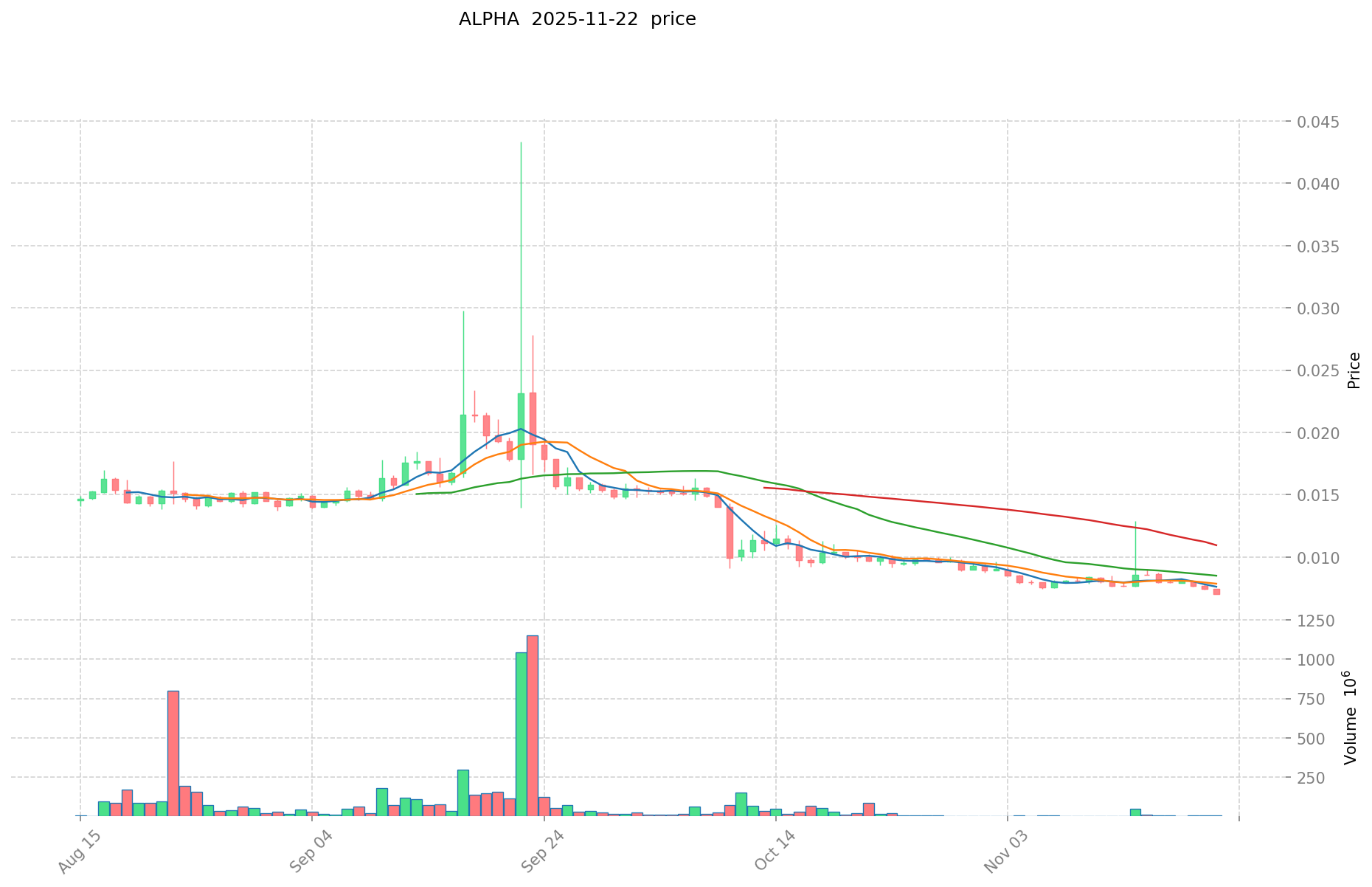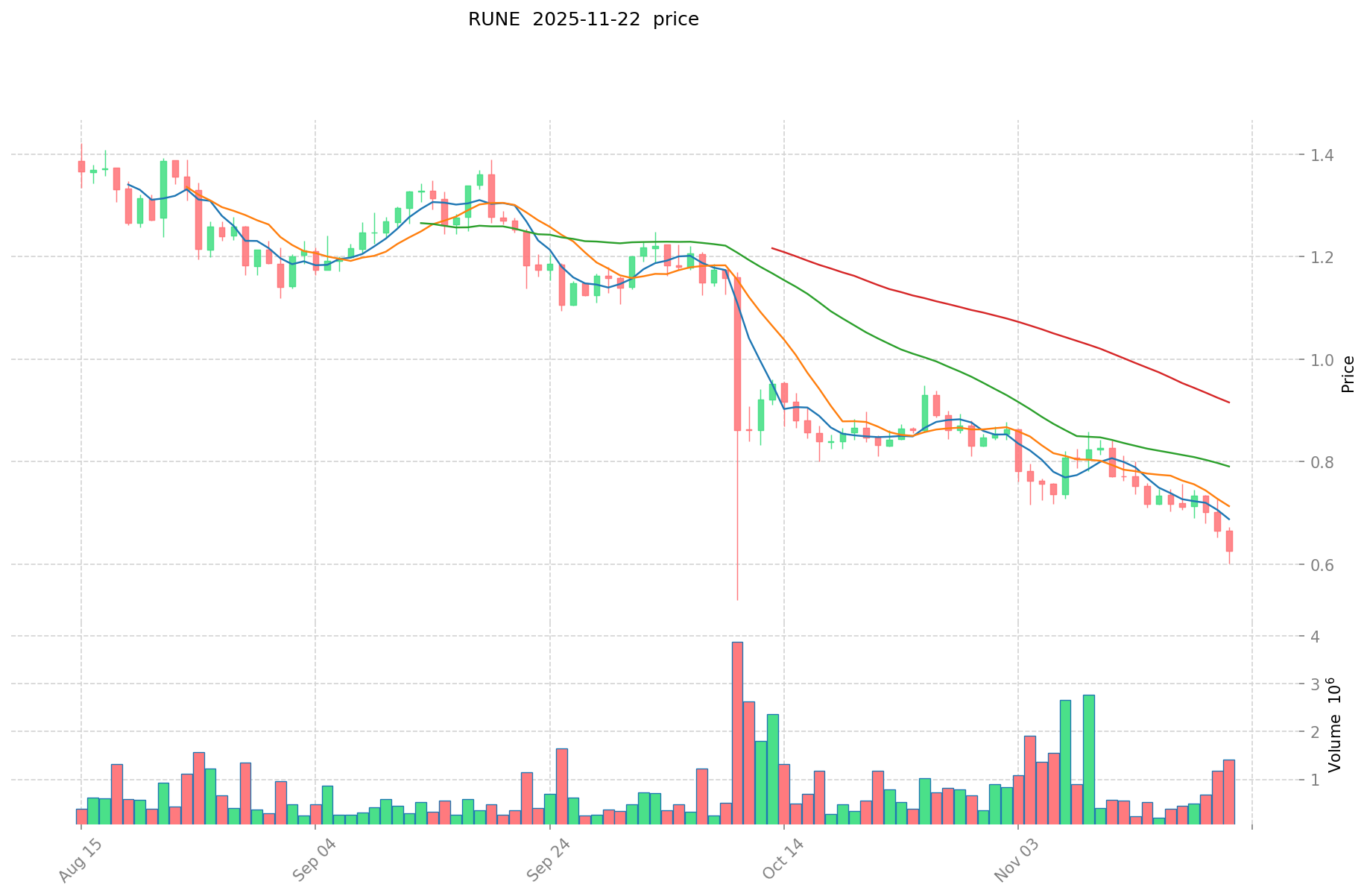ALPHA vs RUNE: The Battle for Crypto Supremacy in Decentralized Finance
Introduction: Investment Comparison of ALPHA vs RUNE
In the cryptocurrency market, the comparison between ALPHA and RUNE has been an unavoidable topic for investors. The two not only show significant differences in market cap ranking, application scenarios, and price performance, but also represent different positioning in the crypto asset space.
Stella (ALPHA): Launched in 2020, it has gained market recognition for its leveraged strategies protocol with 0% cost to borrow.
RUNE (RUNE): Since its inception in 2019, it has been hailed as a highly optimized multi-chain solution, becoming one of the cryptocurrencies with significant trading volume and market capitalization globally.
This article will comprehensively analyze the investment value comparison between ALPHA and RUNE, focusing on historical price trends, supply mechanisms, institutional adoption, technological ecosystems, and future predictions, attempting to answer the question most concerning to investors:
"Which is the better buy right now?"
I. Price History Comparison and Current Market Status
ALPHA (Coin A) and RUNE (Coin B) Historical Price Trends
- 2021: ALPHA reached its all-time high of $2.93 on February 6, 2021.
- 2021: RUNE hit its all-time high of $20.87 on May 19, 2021.
- Comparative analysis: In the recent market cycle, ALPHA has dropped from its all-time high of $2.93 to its current price of $0.007039, while RUNE has fallen from $20.87 to $0.6233.
Current Market Situation (2025-11-22)
- ALPHA current price: $0.007039
- RUNE current price: $0.6233
- 24-hour trading volume: ALPHA $33,611.53 vs RUNE $864,477.34
- Market Sentiment Index (Fear & Greed Index): 11 (Extreme Fear)
Click to view real-time prices:
- View ALPHA current price Market Price
- View RUNE current price Market Price


II. Core Factors Affecting Investment Value of ALPHA vs RUNE
Supply Mechanisms Comparison (Tokenomics)
- ALPHA: Fixed supply with a maximum cap of 1 billion tokens, with 70% allocated to the community. Features deflationary mechanisms through token burning.
- RUNE: Emission-based model with 500 million initial supply, combined with continuous network fee burning mechanism to control circulating supply.
- 📌 Historical Pattern: Deflationary tokenomics in ALPHA has historically created supply pressure during market rallies, while RUNE's bond-stake-burn mechanisms create stabilizing economic incentives during different market cycles.
Institutional Adoption and Market Applications
- Institutional Holdings: RUNE has attracted more significant institutional interest with strategic investments from Framework Ventures, Multicoin Capital, and Pantera Capital, while ALPHA has focused more on community governance.
- Enterprise Adoption: RUNE demonstrates stronger enterprise application in cross-chain liquidity provision, while ALPHA offers more specialized DeFi yield optimization services.
- National Policies: Both tokens face similar regulatory scrutiny as DeFi protocols, with ALPHA's yield products potentially facing more securities-related regulation than RUNE's liquidity protocol.
Technical Development and Ecosystem Building
- ALPHA Technical Upgrades: Recent integration with AlphaLab program to incubate DeFi projects and expansion to multi-chain deployment across BSC, Avalanche, and Ethereum.
- RUNE Technical Development: Implementation of THORChain's synthetic assets and continuous advancement in cross-chain swaps with BTC, ETH and ERC-20 tokens without wrapped assets.
- Ecosystem Comparison: ALPHA has a more focused ecosystem centered on yield optimization and lending, while RUNE's THORChain ecosystem offers broader DeFi infrastructure with native cross-chain swaps, liquidity provision, and synthetic assets.
Macroeconomic Factors and Market Cycles
- Performance in Inflationary Environments: RUNE has shown stronger anti-inflation properties due to its liquidity-based utility and economic design.
- Macroeconomic Monetary Policy: Both tokens show correlation to broader crypto market movements in response to interest rate changes, but RUNE demonstrates higher resilience during market downturns.
- Geopolitical Factors: RUNE's cross-chain capabilities position it advantageously during periods of increased cross-border transaction demand.
III. 2025-2030 Price Prediction: ALPHA vs RUNE
Short-term Prediction (2025)
- ALPHA: Conservative $0.00613263 - $0.007049 | Optimistic $0.007049 - $0.00824733
- RUNE: Conservative $0.423572 - $0.6229 | Optimistic $0.6229 - $0.759938
Mid-term Prediction (2027)
- ALPHA may enter a growth phase, with projected prices $0.0093307613 - $0.013529603885
- RUNE may enter a steady growth phase, with projected prices $0.729447045 - $1.01393139255
- Key drivers: Institutional capital inflow, ETF developments, ecosystem growth
Long-term Prediction (2030)
- ALPHA: Base scenario $0.015510757778022 - $0.018147586600286 | Optimistic scenario $0.018147586600286+
- RUNE: Base scenario $1.23221987966034 - $1.515630451982218 | Optimistic scenario $1.515630451982218+
Disclaimer: This analysis is based on historical data and projections. Cryptocurrency markets are highly volatile and unpredictable. These predictions should not be considered as financial advice. Always conduct your own research before making investment decisions.
ALPHA:
| 年份 | 预测最高价 | 预测平均价格 | 预测最低价 | 涨跌幅 |
|---|---|---|---|---|
| 2025 | 0.00824733 | 0.007049 | 0.00613263 | 0 |
| 2026 | 0.0110133576 | 0.007648165 | 0.00497130725 | 8 |
| 2027 | 0.013529603885 | 0.0093307613 | 0.006904763362 | 32 |
| 2028 | 0.0155450483258 | 0.0114301825925 | 0.005829393122175 | 62 |
| 2029 | 0.017533900096895 | 0.01348761545915 | 0.007148436193349 | 91 |
| 2030 | 0.018147586600286 | 0.015510757778022 | 0.010081992555714 | 120 |
RUNE:
| 年份 | 预测最高价 | 预测平均价格 | 预测最低价 | 涨跌幅 |
|---|---|---|---|---|
| 2025 | 0.759938 | 0.6229 | 0.423572 | 0 |
| 2026 | 0.76747509 | 0.691419 | 0.50473587 | 10 |
| 2027 | 1.01393139255 | 0.729447045 | 0.5981465769 | 17 |
| 2028 | 1.290100043787 | 0.871689218775 | 0.557881100016 | 39 |
| 2029 | 1.38354512803968 | 1.080894631281 | 0.59449204720455 | 73 |
| 2030 | 1.515630451982218 | 1.23221987966034 | 1.133642289287512 | 97 |
IV. Investment Strategy Comparison: ALPHA vs RUNE
Long-term vs Short-term Investment Strategies
- ALPHA: Suitable for investors focused on DeFi yield optimization and community governance
- RUNE: Suitable for investors seeking cross-chain liquidity solutions and broader DeFi infrastructure
Risk Management and Asset Allocation
- Conservative investors: ALPHA: 30% vs RUNE: 70%
- Aggressive investors: ALPHA: 45% vs RUNE: 55%
- Hedging tools: Stablecoin allocation, options, cross-currency portfolio
V. Potential Risk Comparison
Market Risks
- ALPHA: Higher volatility due to smaller market cap and focused ecosystem
- RUNE: Exposure to broader market trends in cross-chain liquidity
Technical Risks
- ALPHA: Scalability, network stability in multi-chain deployment
- RUNE: Complexity of cross-chain operations, potential security vulnerabilities
Regulatory Risks
- Global regulatory policies may impact both tokens differently, with ALPHA potentially facing more scrutiny on yield products
VI. Conclusion: Which Is the Better Buy?
📌 Investment Value Summary:
- ALPHA advantages: Specialized DeFi yield optimization, community-driven governance
- RUNE advantages: Strong institutional backing, cross-chain liquidity solutions, broader DeFi infrastructure
✅ Investment Advice:
- New investors: Consider a higher allocation to RUNE for its more established ecosystem
- Experienced investors: Balanced approach with exposure to both ALPHA and RUNE
- Institutional investors: RUNE may offer more liquidity and cross-chain opportunities
⚠️ Risk Warning: Cryptocurrency markets are highly volatile. This article does not constitute investment advice. None
VII. FAQ
Q1: What are the main differences between ALPHA and RUNE? A: ALPHA focuses on leveraged strategies and yield optimization in DeFi, while RUNE is designed for cross-chain liquidity solutions. ALPHA has a fixed supply with deflationary mechanisms, whereas RUNE uses an emission-based model with continuous burning. RUNE has attracted more institutional interest and has a broader DeFi infrastructure.
Q2: Which token has performed better historically? A: In the recent market cycle, both tokens have experienced significant drops from their all-time highs. RUNE reached a higher all-time high of $20.87 compared to ALPHA's $2.93, but both have seen substantial declines. As of the current date, RUNE is trading at a higher price of $0.6233 compared to ALPHA's $0.007039.
Q3: How do the supply mechanisms of ALPHA and RUNE differ? A: ALPHA has a fixed supply with a maximum cap of 1 billion tokens and features deflationary mechanisms through token burning. RUNE has an emission-based model with an initial supply of 500 million tokens, combined with a continuous network fee burning mechanism to control circulating supply.
Q4: Which token has better institutional adoption? A: RUNE has attracted more significant institutional interest with strategic investments from major venture capital firms like Framework Ventures, Multicoin Capital, and Pantera Capital. ALPHA, on the other hand, has focused more on community governance.
Q5: What are the key technical developments for each token? A: ALPHA has recently integrated with the AlphaLab program to incubate DeFi projects and expanded to multi-chain deployment across BSC, Avalanche, and Ethereum. RUNE has implemented synthetic assets and advanced cross-chain swaps with BTC, ETH, and ERC-20 tokens without wrapped assets.
Q6: How do the long-term price predictions compare for ALPHA and RUNE? A: For 2030, ALPHA's base scenario predicts a range of $0.015510757778022 - $0.018147586600286, while RUNE's base scenario predicts $1.23221987966034 - $1.515630451982218. RUNE is projected to have a higher potential price range in the long term.
Q7: What are the main risk factors for each token? A: ALPHA faces higher volatility due to its smaller market cap and focused ecosystem, as well as potential regulatory scrutiny on yield products. RUNE is exposed to broader market trends in cross-chain liquidity and faces risks related to the complexity of cross-chain operations and potential security vulnerabilities.
Share
Content